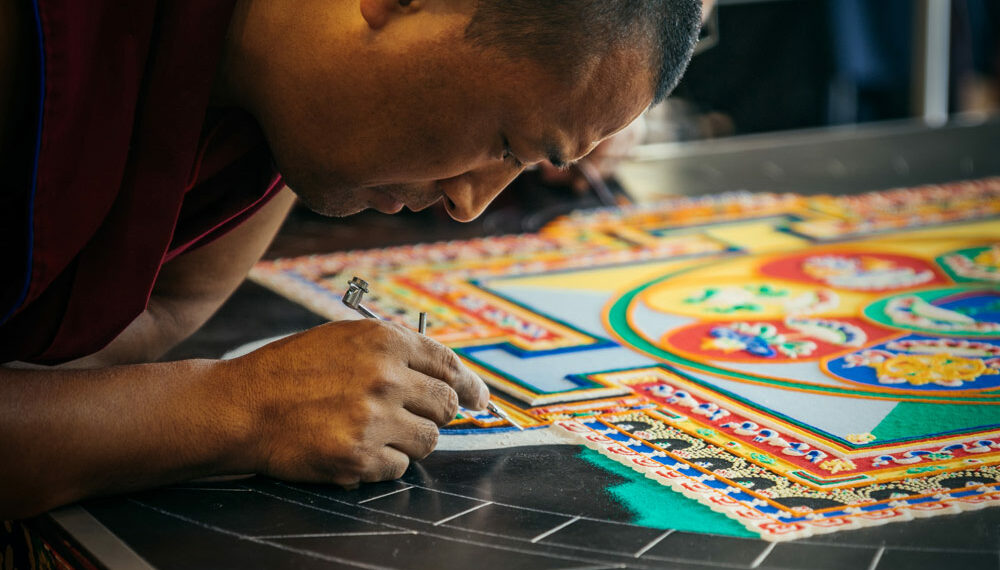Mandalas – the Different Types and Their History
The word mandala comes from the ancient Indian language Sanskrit and means circle, arc, slice, disk. According to some, its meaning is also related to the mind, as the word “manas” means mind, which filters out the information flowing through the senses. Mandalas are used for meditation techniques and practices, especially in India, by followers of Hinduism and Buddhism.
The History of Mandalas
Siddhartha Gautama, the first “Buddha”, was born in a region now known as Nepal into an aristocratic family. Although there is no exact information available about his date of birth, historians believe he may have lived around 560 BC. After Gautama became confronted with human suffering, he left his kingdom and then tried to attain the state of enlightenment through meditation and thoughtful action. He began to preach his teachings in what is today India, where he gained many followers and eventually formed a community of the first Buddhist monks.
Buddhist monks traveled along the Silk Roads, ancient trade routes that connected Asia and Europe, so Buddhism spread in a short time. They took mandalas with them and painted these geometric drawings in other parts of Asia as well. Mandalas eventually appeared in Tibet, China, and Japan by the 4th century. Although the origins of mandalas can be traced to Buddhism, they soon appeared in Hinduism and other religious practices as well.
Types of Mandalas
Throughout the history of mandalas different types of mandalas have evolved in different cultures, which are used for many different purposes, both artistically and spiritually. They basically can be divided into three groups:
1. Teacher Mandala
Teacher mandalas are symbolic and each form, line, and color represents a different aspect of a philosophical or religious system. Each student creates their own mandala, which visually symbolizes all the knowledge acquired so far. Teaching mandalas serve as a colorful, mental map for their creators.
2. Healing Mandala
Healing mandalas are made based on intuition and creativity. They are created for meditation purposes. Their goal is to provide wisdom, evoke a sense of calm, and manage focus and concentration. If we concentrate for a long time on the inner center of a mandala, we can reach a modified state of consciousness.
3. Sand Mandalas
Buddhist monks have long been using sand mandalas as a religious element. For some religious holidays, mandela with up to several meters in diameter can be prepared and eventually swept away. Some mandalas can take several months to make.
[youtube v=”JdUFqkX2d6I”]
The Meaning of Mandala Colors:
- White: relief, perfection, compassion, serenity.
- Black: secret, intuition, insight, rebirth.
- Gray: spiritual healing, meekness, love, fidelity.
- Yellow: friendliness, receptivity, nature, intelligence.
- Blue: satisfaction, relaxation, harmony.
- Fiery red: fearlessness, power, change, love.
- Purple: charity, idealism, wisdom.
- Pink: sensitivity, healing of the “inner”, universal healing.
- Orange: self-control, vitality, ambition, intuition.
- Green: growth, trust, relationship, healing, serenity.
- Brown: proximity to the earth, stability, conscious attachment to the environment.
- Silver: supernatural, supernatural abilities, overflowing emotions, prosperity.
Making a mandala is a meditative ceremony. Mandalas are said to lead their creators and spectators through a process of transformation. Going from the outside in, it symbolizes that a state of joy can be attained from suffering. The center is the infinite space, the plane of the creator. The mandala symbolizes the creator, shows how the universe is created, how it is transformed, and at the same time how one remains united with the creator and the great whole. The circle shape also contains the cycle of life and the dualities of the dual world.
Every mandala is different. Anyone can make one for their home, we hope you feel the same and make one for yourself, as mandalas creating mandalas can be very relaxing and with that be a part of a conscious lifestyle.
Have a good time diving deep into a mandala for everyone!
 English
English magyar
magyar